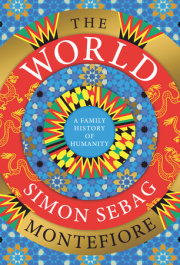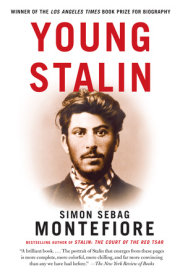INTRODUCTION
As the tide fell, the footsteps emerge. The footsteps of a family walking on the beach of what is now a small village in eastern England, Happisburgh. Five sets of footprints. Probably a male and four children, dating from between 950,000 and 850,000 years before the present. These, discovered in 2013, are the oldest family footprints ever found. They are not the first: even older footprints have been found in Africa, where the human story started. But these are the oldest traces of a family. And they are the inspiration for this history of the world.
There have been many histories of the world, but this one adopts a new approach, using the stories of families across time to provide a different, fresh perspective. It is one that appeals to me because it offers a way of connecting great events with individual human drama, from the first hominins to today, from the sharpened stone to the iPhone and the drone. World history is an elixir for troubled times: its advantage is that it offers a sense of perspective; its drawback is that it involves too much distance. World history often has themes, not people; biography has people, not themes.
The family remains the essential unit of human existence—even in the age of AI and galactical warfare. I have woven history together telling the stories of multiple families in every continent and epoch, using them to tether the onward rush of the human story. It is a biography of many people instead of one person. Even if the span of these families is global, their dramas are intimate—birth, death, marriage, love, hate; they rise; they fall; rise again; they migrate; they return. In every family drama, there are many acts. That is what Samuel Johnson meant when he said every kingdom is a family and every family a little kingdom.
Unlike many of the histories that I grew up with, this is a genuine world history, not unbalanced by excessive focus on Britain and Europe but rather giving Asia, Africa and the Americas the attention they deserve. The focus on family also makes it possible to pay more attention to the lives of women and children, both of whom were slighted in the books I read as a schoolboy. Their roles— like the shape of family itself—change through the arc of time. My aim is to show how the fontanelles of history grew together.
The word family has an air of cosiness and affection, but of course in real life families can be webs of struggle and cruelty too. Many of the families that I follow are power families in which the intimacy and warmth of nurture and love are at once infused and distorted by the peculiar and implacable dynamics of politics. In power families, danger comes from intimacy. ‘Calamity,’ as Han Fei Tzu warned his monarch in second-century bc China, ‘will come to you from those you love.’
‘History is something very few people were doing,’ writes Yuval Noah Harari, ‘when everyone else was ploughing fields and carrying water buckets.’ Many of the families I choose are ones that exercise power, but others encompass enslaved persons, doctors, painters, novelists, executioners, generals, historians, priests, charlatans, scientists, tycoons, criminals—and lovers. Even a few gods.
Some will be familiar, many will not: here we follow the dynasties of Mali, Ming, Medici and Mutapa, Dahomey, Oman, Afghanistan, Cambodia, Brazil and Iran, Haiti, Hawaii and Habsburg; we chronicle Genghis Khan, Sundiata Keita, Empress Wu, Ewuare the Great, Ivan the Terrible, Kim Jong-un, Itzcoatl, Andrew Jackson, King Henry of Haiti, Ganga Zumba, Kaiser Wilhelm, Indira Gandhi, Sobhuza, Pachacuti Inca and Hitler alongside Kenyattas, Castros, Assads and Trumps, Cleopatra, de Gaulle, Khomeini, Gorbachev, Marie Antoinette, Jefferson, Nader, Mao, Obama; Mozart, Balzac and Michelangelo; Caesars, Mughals, Saudis, Roosevelts, Rothschilds, Rockefellers, Ottomans.
The lurid coexists with the cosy. There are many loving fathers and mothers but also ‘Fatso’ Ptolemy IV dismembers his son and sends the parts to the child’s mother; Nader Shah and Empress Iris blind their sons; Queen Isabella tortures her daughter; Charlemagne possibly sleeps with his; Ottoman power mother Kösem orders the strangling of her son and in turn is strangled on the orders of her grandson; Valois potentate Catherine de’ Medici orchestrates a massacre at the wedding of her daughter whose rape by her sons she seems to have condoned; Nero sleeps with his mother, then murders her. Shaka kills his mother, then uses it as a pretext to launch a massacre. Saddam Hussein unleashes his sons against his sons-in-law. The killing of brothers is endemic—even now: Kim Jong-un has recently murdered his brother in a very modern way using a reality-show stunt as cover, a nerve agent as poison.
We follow the tragedies too of teenaged daughters, dispatched by cold parents to marry strangers in faraway lands where they then die in childbirth: sometimes their marriages facilitated affinities between states; more often, their sufferings achieved little since family connections were totally trumped by interests of state. We also follow enslaved women who rise to rule empires; here is Sally Hemings, enslaved half sister of Thomas Jefferson’s late wife, secretly bearing the president’s children; here is Razia of the Delhi sultanate who seizes power as sovereign but is destroyed by her relationship with an African general; in al-Andalus, a caliph’s daughter, Wallada, becomes poetess and libertine. Following our chosen families through pandemics, wars, floods and booms, we chart the lives of women from the village to the throne to the factory and the premiership, from catastrophic maternal mortality and legal impotence to the rights to vote, to abortion and contraception; and the trajectory of children from devastating child mortality to industrialized labour and the modern cult of childhood.
This is a history that focuses on individuals, families and coteries. There are many other ways of approaching history with this span. But I am a historian of power and geopolitics is the engine of world history. I have spent most of my career writing about Russian leaders, and this is the sort of history I have always enjoyed reading—it encompasses passions and furies, the realm of the imagination and senses, and the grit of ordinary life in a way missing from pure economics and political science. The centrality of this human connection is a way of telling the global story that shows the impact of political, economic and technical changes while revealing how families too have evolved. This is another bout in the long struggle between structure and agency, impersonal forces and human character. But these are not necessarily exclusive. ‘Men make their own history,’ wrote Marx, ‘but they don’t make it as they please; they don’t make it under self-selected circumstances, but under circumstances existing already, given and transmitted from the past.’ So often history is presented as a staccato series of events, revolutions and paradigms, experienced by neatly categorized, narrowly identified people. Yet the lives of real families reveal something different—idiosyncratic, singular people living, laughing, loving over decades and centuries in a layered, hybrid, liminal, kaleidoscopic world that defies the categories and identities of later times.
The families and characters I follow here tend to be exceptional—but they also reveal much about their era and place. It is a way of looking at how kingdoms and states evolved, at how the interconnectivity of peoples developed, and at how different societies absorbed outsiders and merged with others. In this multifaceted drama, I hope that the simultaneous, blended yet single narrative catches something of the messy unpredictability and contingency of real life in real time, the feeling that much is happening in different places and orbits, the mayhem and the confusion of a dizzying, spasmodic, bare-knuckle cavalry charge, often as absurd as it is cruel, always filled with vertiginous surprises, strange incidents and incredible personalities that no one could foresee. That’s why the most successful leaders are visionaries, transcendent strategists but also improvisers, opportunists, creatures of bungle and luck. ‘Even the shrewdest of the shrewd,’ admitted Bismark ‘goes like a child into the dark.’ History is made by the interplay of ideas, institutions and geopolitics. When they come together in felicitous conjunction, great changes happen. But even then, it is personalities who roll the dice....
Copyright © 2023 by Simon Sebag Montefiore. All rights reserved. No part of this excerpt may be reproduced or reprinted without permission in writing from the publisher.


















